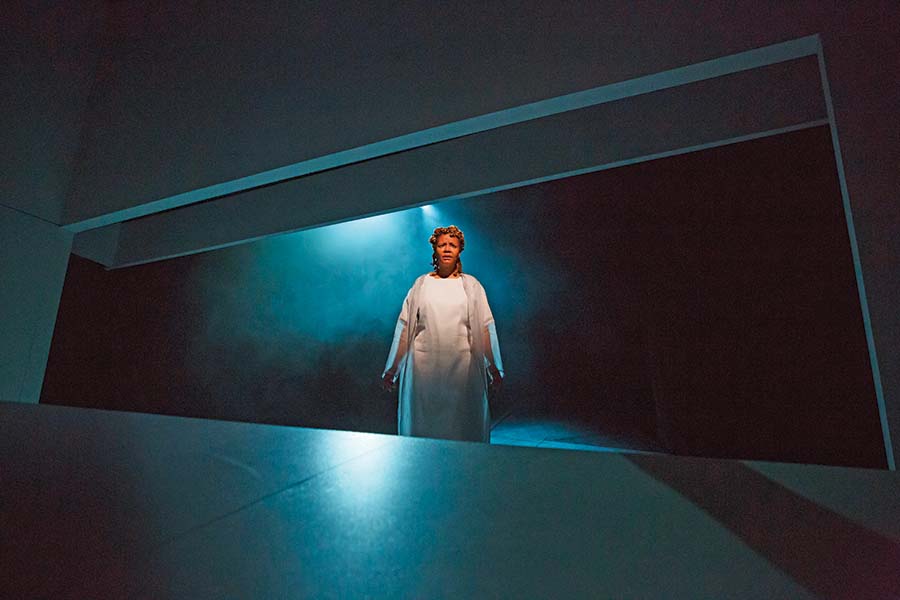
It was in 2002 that director Lileana Blain-Cruz and Branden Jacobs-Jenkins met as undergraduates at Princeton University, but it wasn’t until a full decade later that they first collaborated on a dance-theatre piece by Berlin-based artist Isabel Lewis. (Blain-Cruz directed, Jacobs-Jenkins “danced,” and shortly after the show closed the dance venue filed for bankruptcy.) In 2014 they reunited to work on War at Yale Repertory Theatre in New Haven, Conn., and later at Lincoln Center Theater’s LCT3 in New York City, this time with Jacobs-Jenkins in a decidedly more comfortable role as playwright. Here they discuss the play, published in full in the April 2017 issue of American Theatre, and their work together.
LILEANA BLAIN-CRUZ: We’ve talked a lot about how War was influenced by your time in Berlin, but is that where the idea began?
BRANDEN JACOBS-JENKINS: It actually started with an interest in thinking through what a “black family drama” might actually mean, given the historical slipperiness of a concept like “blackness”—or even “whiteness”—in the first place. Like: What exactly makes a family “black” or not “black” dramatically? And since when? And says who? Initially, I had conceived of—and, honestly, it’s still my intention to try and pull this off—a sort of sweeping saga tracking one black family over multiple generations, but which was also somehow deconstructing the evolution of “blackness” as a concept alongside it. My time in Berlin became key insofar as it was there that I had my firsthand experience of American blackness’s true “outer limits.”
On my very first day in Berlin, after moving there in 2010 on a research fellowship, these women were sitting across from me on a train openly debating my ethnicity and thinking that I didn’t speak German—like, “Is he Moroccan? Turkish? Indian?” “No, but he must be Arab? Turkish?” “What is he?” And eventually I spoke up and was like, “I’m American.” And they were like, “Oh my God, duh—you’re American, of course.” Their anxiety and then relief about “what I was” seemed so loaded and I couldn’t stop thinking about it, and eventually my very lovely Chilean roommate had to explain to me that it was probably the relative lightness of my complexion and the way that I dressed (i.e., like a hipster) which had thrown them off—that “black” to them generally meant African immigrant (i.e., dark-skinned and not hipster). Their confusion had to do with the relative “privilege” I seemed to project being in tension with my skin color, and hearing I was an American suddenly resolved that, because “American” was synonymous with privilege, e.g., somehow “beyond” race as they saw it.
So for the first time in my life, I was being read as “American” more comfortably than I was being read as “black,” which was incredibly surreal coming, as I did, from a culture where I was constantly being required to articulate myself in just the opposite order—which is to say through a narrative of social oppression. And this, I would argue, has something to do with the presence of the black GIs, who first show up as a part of the American military occupation post-WWII. So, very early, black Americans there have become synonymous with Americanness, which is to say more closely aligned with oppressing than being oppressed. Essentially, I had this “aha” moment where I wanted to locate this family story around WWII and look at the moment when the concept of American blackness became somehow doubled or bifurcated and somehow exported—when America’s “race problem” became not just a significant facet of domestic policy but American foreign policy as well in this country’s march towards becoming a global superpower.
You talk about writing from a place of privilege, and in War it’s a very specific choice to make this about a wealthy black family.
Well, if you’re going to talk about “evolutions” of blackness and Americanness in the 20th century, I think you can’t not talk about things like class mobility, both up and down. And in my opinion this diversity and multiplicity of “black experience” along class lines becomes an important site of engagement in terms of pinning down what exactly we’re talking about when we talk about race in America. I get so nervous when we start purely normalizing “blackness” as a kind of impoverishment or brokenness. Blackness is not defined by socioeconomic status—poverty definitely is, and black poverty does exist—but when we talk about blackness, I think we’re talking about something much more involved. We’re talking—and I use these words again—about a concept that is constantly being debated and being challenged and fought over in terms of meaning and value.

This play moves differently than some of your other work—say, An Octoroon, which is formally a response to melodrama. Here we move between incredibly different theatrical landscapes, for example, the children in the hospital room and Roberta’s comatose state. How would you describe the formal shifts that happened there?
In the spirit of concepts and ideas and people moving back and forth across languages and continents and cultures, I was interested in making a piece that could move back and forth between my ideas of an “American” and a “German” dramaturgy—a play that is somehow literally half-German, half-American, but all “black.” Three German playwrights I found myself reading and watching and thinking about a lot were Elfriede Jelinek, Roland Schimmelpfennig, and René Pollesch, and I found myself very inspired by their use of language (especially Jelinek and Pollesch) and theatricality (Schimmelpfennig) and the way that they created these characters that weren’t exactly people but somehow thought-in-action, and which were constantly deconstructing some sense of themselves through language. So in War, this hospital deathbed family drama lives in a kind of realism out of which these strange, dense, hallucinatory, speech-act language-torrent things might emerge—Roberta’s internal space. I was trying to get those two modes of storytelling to coexist in the same play-world. That potential of that kind of stylistic whiplash felt really interesting to me.
That was one of the things that I loved about the play—having to move back and forth between those places and the marriage of those two different worlds. Between the two productions, in terms of it growing for you from Yale to LCT3, what discoveries were most significant to you?
The productions were actually so different, and I think our major discovery was about how it’s harder to drop into naturalism after something more expressionistic than the other way around. It might be that American audiences need to be cared for upfront a little more than I think your average non-American Western theatregoer does. But alienation effects land so strongly here in a way that they don’t abroad—maybe because it’s so taken for granted? Scale is also really important too, because it was so hard in that big space [at Yale] to communicate the intimacy and the weirdness of the hospital room. But I thought that really having that body up in your face at the Claire Tow [at LCT3] added a different emotional color to the scene.
You also talked about going to shows there, and how because there were no black people to perform in certain plays, they would use gorilla masks.
In my experience, it was either gorilla masks, grass skirts, blackface, or Afro wigs. What’s weird and actually sort of funny is that you get the sense they don’t actually think they’re being derisive, but that this is a choice born of necessity and a genuine desire to be putting work on the stages which reflects the diversity of humanity. The problem is that they just don’t have the bodies to do it; it’s like an infrastructural issue. Over there, in order to be a professional actor, you pretty much have to have graduated from one of a handful of acting schools, but of course that becomes about who is being let into these schools, who is applying to these schools, and what people are seeing onstage that would make them interested in applying to these schools in the first place. As result, there’s this sort of weird feedback loop of representation, where, due to the absence of certain voices and bodies, stories of those voices and bodies get told through some kind of distortion. I mean, I say this as if this isn’t a problem here too, but over there, it’s like even more normalized somehow and the results can be like a very bone-chilling trip to Party City.
Speaking of complicated associations and historical images, how did you feel when you first were starting to write the character Alpha in Roberta’s dream landscape, and where are you with it now?
That choice definitely grew out of my experiences seeing all these plays in Germany with gorillas in them and really meditating on why that particular idea has the kind of currency it does and trying to explore the limits of its significance. We all know that we share an incredible amount of genes with chimpanzees, and so much about wars that have a racial element to them are all about people challenging each other’s ideas of who gets to be counted as human. But, simultaneously, we think of war as not a human thing—it’s something that even primates are seen to engage in. We even have this notion of “ape brain.” We think of the things that we actually share with apes, and for a long time, we thought the things that distinguish us from apes were things like language. But actually they do have a language, and things suddenly get sort of hairy when we really try and start thinking about what being a human really even is.
Are you going to continue your work on this family saga?
I think I have to. I’ve definitely had phases where I’m like, “Oh my God, this is too hard! I give up!” But then a day or two goes by and I realize that I really can’t seem to let it all go.


